
Speckled Rattlesnake (Crotalus mitchellii)
Snakes Around Las Vegas, Wildlife Around Las Vegas
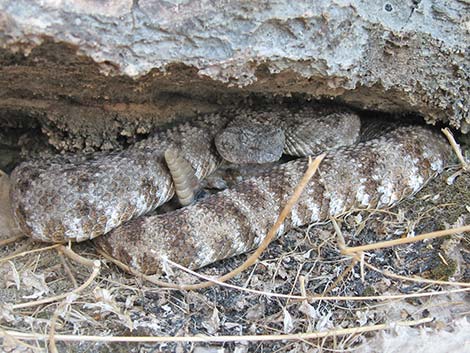 Someone doesn't want to come out and play |
General Description: Speckled Rattlesnakes (Crotalus mitchellii), formerly one species with several subspecies, recently was split into three species: Panamint Rattlesnake (Crotalus stephensi), Southwestern Speckled Rattlesnake (Crotalus pyrrhus), and San Lucan Speckled Rattlesnake (Crotalus mitchellii). To the untrained eye, these snakes all look alike: gray faces (no black-and-white eye stripes), faded colors, body marking on the front-end are blotches and tiger stripes on the back-end, black-and-white banded tails, and light-colored scales with black speckling (the "speckles" of the Speckled Rattlesnake). Around Las Vegas, the easiest way to identify our two species is by geographic range (see below). For those who look carefully, there are details of certain head scales and some subtle color pattern differences that can be used to identify our two species. Without getting too close, Southwestern Speckled Rattlesnakes colors are more faded, and the bands at the end of the tail have narrow black rings. These snakes are venomous. Do not attempt to handle rattlesnakes; rather, enjoy your good luck of finding one from a distance (minimum 3 feet away) and leave them alone. |
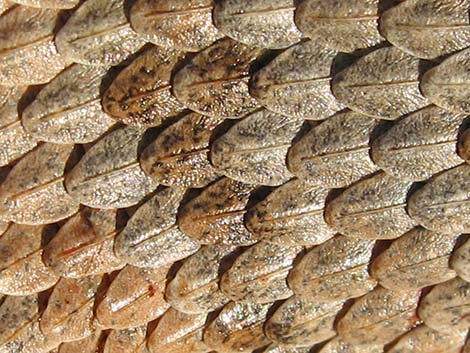 Speckling on the scales |
Family: Venomous Snakes (Viperidae). Formerly Crotalus mitchellii pyrrhus and Crotalus mitchellii stephensi. Crotalus mitchellii is retained for the species that occurs on the southern end of Baja California. Technical Description: Size medium (to 4 ft). Body thick and heavy. Head wide and triangular with a narrow neck. Dorsal color harmonizes with the habitat and ranges from nearly patternless light colors to broadly banded with rust and gray. Scales are rough and flecked with black and white. The sides of the head are gray and contrast with brownish on the top of the head. The tail is banded with black and white rings; the white rings are wider than the black rings, and the black rings tend to incompletely circle the tail. |
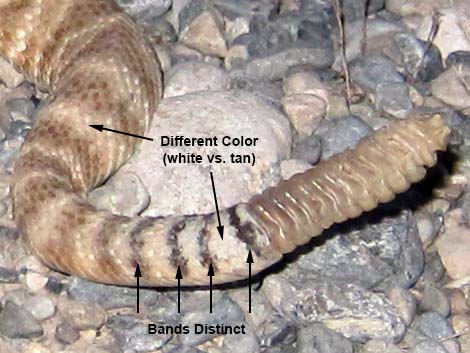 "Coon tail" markings distinct; white (not tan) ground color |
The two species (comparison photos below) around Las Vegas are best recognized by features of the supraocular scale (scale above the eye) and by the nature of the little scales surrounding the rostral scale (the big scale on the tip of the nose). Southwestern Speckled Rattlesnakes (C. pyrrhus) have a crease on the supraocular scale and a band of four small scales adjacent to the rostral scale that separate the rostral and prenasal scales. Panamint Rattlesnakes (C. stephensi) have a pit on the supraocular scale and the prenasal scales contact the rostral scale. Both species are also described as being faded, that is, not having bold colors. However, they differ slightly in the amount of fading. Panamint Rattlesnakes are somewhat less faded, while Southwestern Speckled Rattlesnakes are somewhat more faded. |
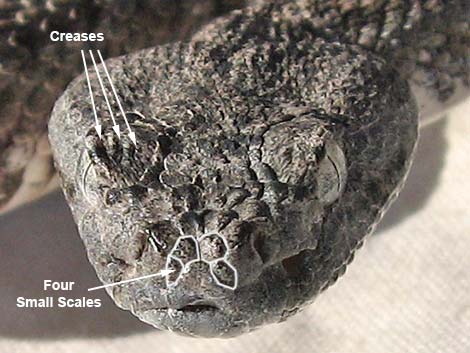 Supraocular scale creased; prenasal scales not touching rostral |
Diet: Primarily rodents. Larger individuals may take small rabbits; young may feed on lizards. Habitat: Mojave Desert Scrub, Blackbrush, Sagebrush, and Pinyon-Juniper Woodlands (Upper Sonoran and Pinyon-Juniper Woodland life zones). Primarily found in rocky areas with outcrops and boulders. |
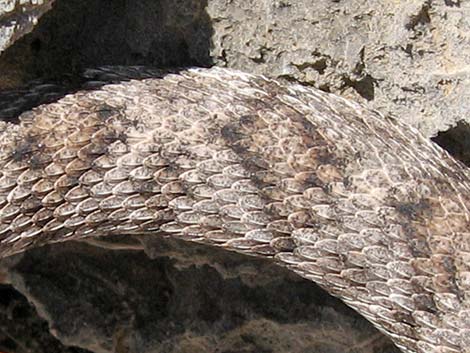 Faded pattern |
Range: Southeastern California, southern Nevada, southwestern Arizona, and northwestern New Mexico from sea level to 8,000 ft in elevation. Both species occur in southern Nevada. The Southwestern Speckled Rattlesnake (C. pyrrhus), the lighter form, occurs in the central and eastern portions of Clark County (e.g., Lake Mead) from Lincoln County south and east into Mexico and Arizona; while the Panamint Rattlesnake (C. stephensi), a darker form, occurs in western Clark County (e.g., Red Rock Canyon NCA) and points west and north into California. Breeding: Gives birth to 2-11 live young during mid-summer. Similar Species: Other species of rattlesnake in southern Nevada tend to have more distinct markings on the back, less speckling, and distinct diagonal eye-lines, but definite identification may require counting scales on the snout (not recommended). |
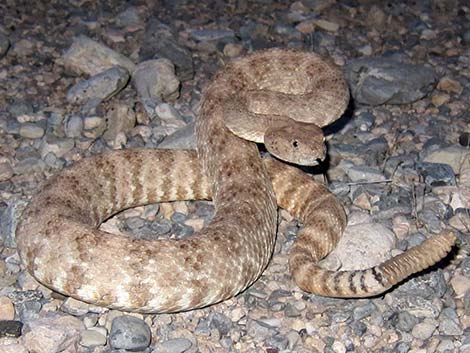 Black "Coon tail" markings narrow to the end |
Comments: Although rarely seen, these two species are the most common rattlesnakes around Las Vegas. Even so, I've only seen a handful in my years of hiking. Rattlesnakes have infrared detectors in pits on the side of the face (between the nostril and eye) that allow them to see the "heat" of warm-blooded animals in total darkness. This makes them look like they have two nasal openings on each side of the face. |
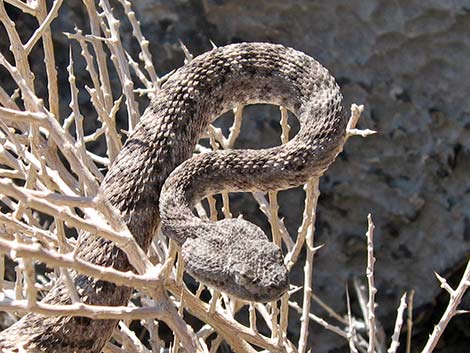 Speckled Rattlesnakes are good climbers |
Southwestern Speckled Rattlesnake (Crotalus pyrrhus) Range: central and eastern Clark County (e.g., Lake Mead) from Lincoln County south and east Panamint Rattlesnake (Crotalus stephensi) Range: western Clark County (e.g., Red Rock Canyon NCA) and points west and north |
Comparison of the two species
Panamint Rattlesnake (Crotalus stephensi): prenasal contacts rostral, pitted supraocular.

Southwestern Speckled Rattlesnake (Crotalus pyrrhus): prenasal separated from rostral by small scales, creased supraocular.

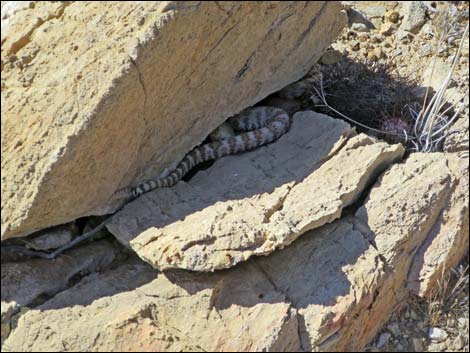 Southwestern Speckled Rattlesnake in typical rocky habitat |
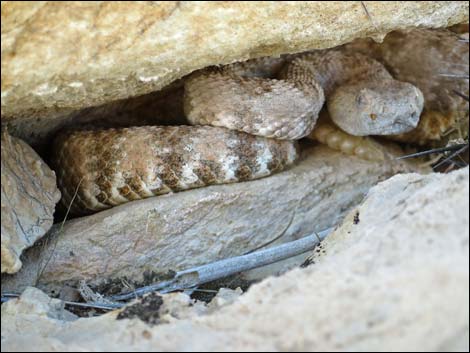 Southwestern Speckled Rattlesnake in typical rocky habitat |
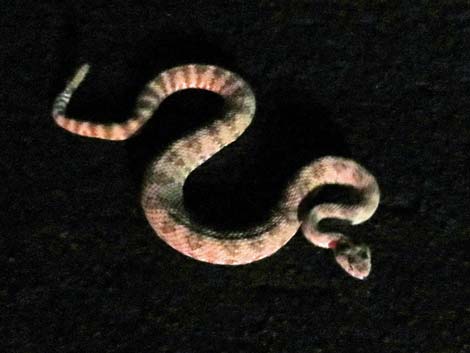 Speckled Rattlesnake on pavement at night |
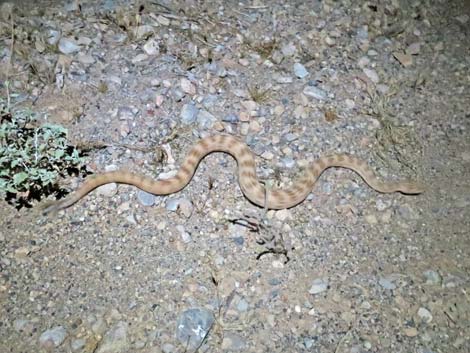 Speckled Rattlesnake racing for the hills |
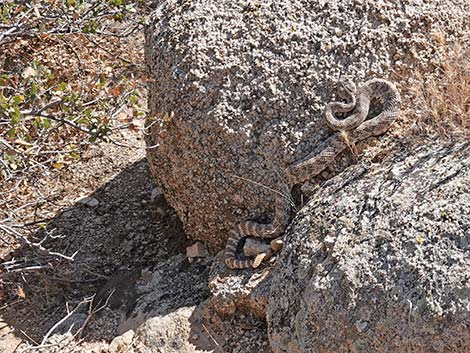 Southwestern Speckled Rattlesnake in rocky hills |
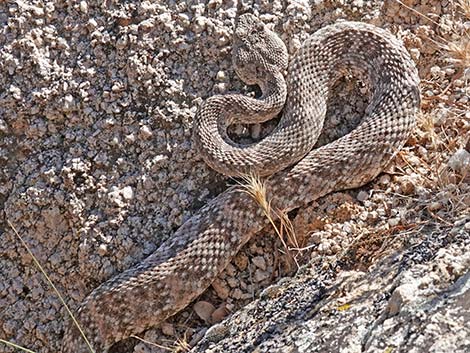 Southwestern Speckled Rattlesnake in rocky hills |
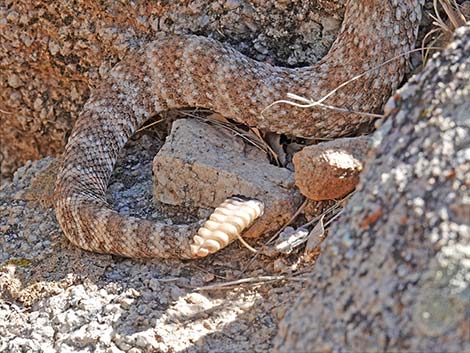 Southwestern Speckled Rattlesnake in rocky hills |
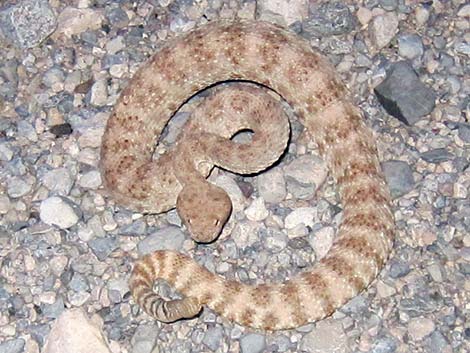 Southwestern Speckled Rattlesnake crossing a wash |
 Southwestern Speckled Rattlesnake: note tail bands |
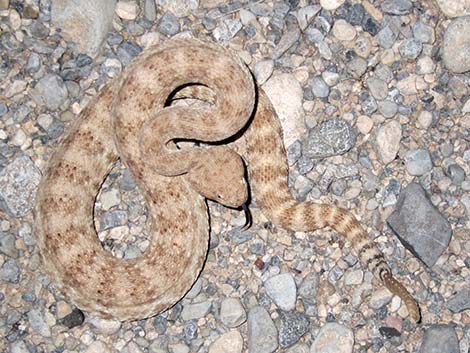 Southwestern Speckled Rattlesnake: note tail bands |
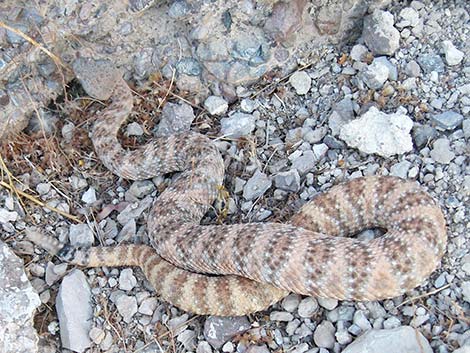 Anterior end is blotched; posterior end is tiger-striped |
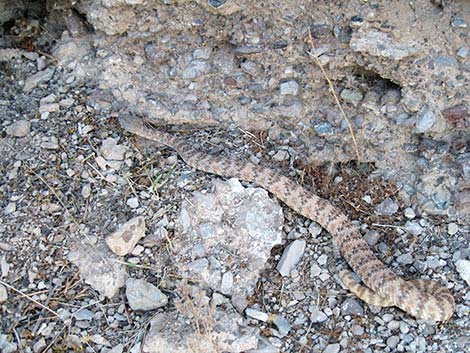 Heading for a tortoise burrow where it can hide |
Note: All distances, elevations, and other facts are approximate.
![]() ; Last updated 220820
; Last updated 220820
| Snakes Around Las Vegas | Wildlife Around Las Vegas | Glossary | Copyright, Conditions, Disclaimer | Home |